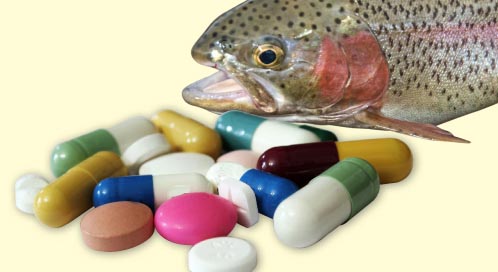Factory farms on land and at sea have become breeding grounds for drug-resistant microorganisms.
By: Anthony Pahnke (vice president of Family Farm Defenders and associate professor of international relations at San Francisco State University) and Ryan Horwarth (fisherman and founder of Pacific Cloud Seafoods, based in Buffalo, NY)
Originally published by the Progressive, Aug. 6th, 2024
If you’ve ever caught a fish, you know that keeping hold of them is hard.
Now imagine taking a syringe and injecting that fish with antibiotics—not just a difficult task, but a strange one. This is exactly what some large-scale fish farms do, along with dumping antibiotics into densely packed pens or mixing drugs into feed. Like concentrated animal feeding operations (CAFOs) on land, industrial fish farms administer antibiotics to stem the outbreak of diseases that fish contract from living in such cramped spaces.
But solving one problem creates another. Factory farms on land and at sea have become breeding grounds not just for livestock, poultry and fish, but also for drug-resistant microorganisms such as Salmonella and E. coli. The World Health Organization (WHO) has criticized CAFOs for this reason. Some estimate that more than 70 percent of the global supply of antibiotics are used on animals in these kinds of operations.
This arrangement benefits pharmaceutical companies like Merck, which employs hundreds of lobbyists each year to convince consumers and policymakers that factory farming is a necessity. Its subsidiary, Merck Animal Health, is an officer company of Stronger America Through Seafood, an industry group pushing for the development of intensive finfish aquaculture in U.S. waters, which would export the factory farming model from land to sea.
Despite the Food and Drug Administration (FDA) prohibiting the use of antibiotics to promote animal growth, there was a 12 percent increase in animal antibiotic sales between 2017 and 2022. This development, and, with it, persistent concerns about human health, led Senator Cory Booker, Democrat of New Jersey, in July to send a letter to the FDA calling on the agency to provide information about its efforts to manage the growing antimicrobial resistance crisis and the overuse of antibiotics in concentrated animal agriculture operations.
The truth is, neither farming nor fishing need to be done this way. We both come from families with farming and fishing traditions centered on treating animals with respect. When you operate on a smaller scale, it’s more feasible to use holistic practices, and you don’t need the same industrial solutions—like intensive antibiotics use—as you do for factory-style food production.
Legislation currently being debated, namely the Improving Agriculture, Research, Cultivation, Timber and Indigenous Commodities (ARCTIC) Act and the Processing Revival and Intrastate Meat Exemption (PRIME) Act, would create opportunities for community-based fishing and farming families like ours to provide high-quality, drug-free food to local markets.
Both bills include provisions to improve processing, which is often a bottleneck when it comes to keeping food supply chains localized and transparent. The Improving ARCTIC Act creates pilot grant programs to strengthen domestic seafood processing and working waterfront economies in coastal communities. The PRIME Act allows small farmers and ranchers to slaughter and process their livestock at local, custom slaughter facilities. In expanding processing options and infrastructure, both acts allow small-scale food producers to better plug into local markets and get more nutritious local food to consumers.
Currently, the PRIME Act is in both the House and Senate versions of the Farm Bill. The Improving ARCTIC Act could also find its way into the mega omnibus bill as it meanders through Congress.
Let’s do what we can to keep fish, and other animals, off drugs. An important step in achieving this is to empower traditional and small-scale food producers that have holistic, stewardship-based relationships with the animals, lands and waters they work with. The legislative tools are there, that is if our lawmakers want to care for the health of our shared lands and waters, our food supply and us.

